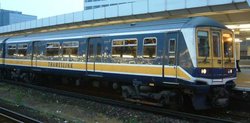London commuter belt
|
|
Liverpool_Street_station_concourse.jpg
The London Commuter Belt or London Metropolitan Area is the name given to the built-up area surrounding and running into Greater London but not administered as part of it.
| Contents |
Scale
The boundaries are not fixed and tend to rise as travel speeds increase and currently cover much of the South East England and East of England regions including the home counties of Kent, Surrey, Berkshire, Buckinghamshire, Hertfordshire and Essex.
As of the 2001 census the London Metropolitan Area had a population of 13,945,000. This makes it 16th largest in the world. This definition is not however widely familiar in the United Kingdom.
Environs of Greater London
There are eighteen boroughs and districts that have a border with Greater London and in some cases form part of the urban sprawl. These are (listed in order as they surround London clockwise from the Thames at Dartford):
- Kent - Dartford, Sevenoaks
- Surrey - Tandridge, Reigate and Banstead, Epsom and Ewell, Mole Valley, Elmbridge, Spelthorne
- Berkshire - Windsor and Maidenhead, Slough
- Buckinghamshire - South Bucks
- Hertfordshire - Three Rivers, Hertsmere, Welwyn Hatfield, Broxbourne
- Essex - Epping Forest, Brentwood, Thurrock
These districts in many cases have sections within the M25 and, in the case of Epping Forest and Three Rivers, are served by the London Underground. Some of these districts formed part of the Metropolitan Police District until its borders were altered to coincide with Greater London in 2000.
Further out
Beyond these districts are dormitory towns and ribbon developments which have occurred around major roads and railway lines whose economy relies entirely on the capital. Even further still are other towns with an economy independent of London who also serve as commuter bases.
Towns
Indicative and by no means exhaustive list of towns in the area:
- Abbots Langley, Addlestone, Amersham, Ashstead, Aylesbury
- Banstead, Basildon, Beaconsfield, Bedford, Berkhamstead, Billericay, Borehamwood, Brentwood, Burnham, ByfleetMissing image
Uk-reading-st-marys.jpgReading, Berkshire - Caterham, Cheshunt, Chertsey, Chesham, Chigwell, Chorleywood, Cobham, Crawley
- Dartford, Dorking
- East Grinstead, Egham, Epping, Epsom
- Farnborough, Fleet, Flitwick
- Gerrards Cross, Gravesend, Grays, Guildford
- Harlington, Harlow, Harpenden, Hatfield, Haywards Heath, Hemel Hempstead, Hextable, High Wycombe, Horley, Horsham
- Kings Langley
- Leatherhead, Loughton, Luton
- Medway, Maidstone
- Northfleet
- Ongar, Oxshott
- Potters Bar
- Radlett, Rayleigh, Reading, Redhill, Reigate, Rickmansworth, Rochester
- St Albans, Sevenoaks, Slough, South Mimms, South Oxhey, Southend-on-Sea, St Albans, Staines, Swanley
- Tadworth, Theydon Bois, Thurrock, Tilbury, Tonbridge, Tring, Tunbridge Wells
- Waltham Abbey, Waltham Cross, Walton-on-Thames, Warlingham, Warlington, Watford, Welwyn Garden City, Weybridge, Windsor, Woking
Green Belt
Much of the undeveloped part of this area lies within a designated Metropolitan Green Belt so further significant urban development is generally resisted by District Councils backed by the Planning Inspectorate. It was expected that had this policy not been adopted during the 1940s and 1950s the area now perceived as the commuter belt would have been fully urbanized by about 1980, and the administrative boundaries of Greater London might well have been more extensive.
Future
The approval, in principle, of a second runway at Stansted Airport and the introduction of domestic train services along the Channel Tunnel Rail Link being built between St Pancras railway station, Stratford International station in East London and stations at Ebbsfleet and Ashford in Kent are expected to pull the area's limits outwards in north easterly and south easterly directions (respectively) bringing greater symmetry to the commuter belt as seen from above.

